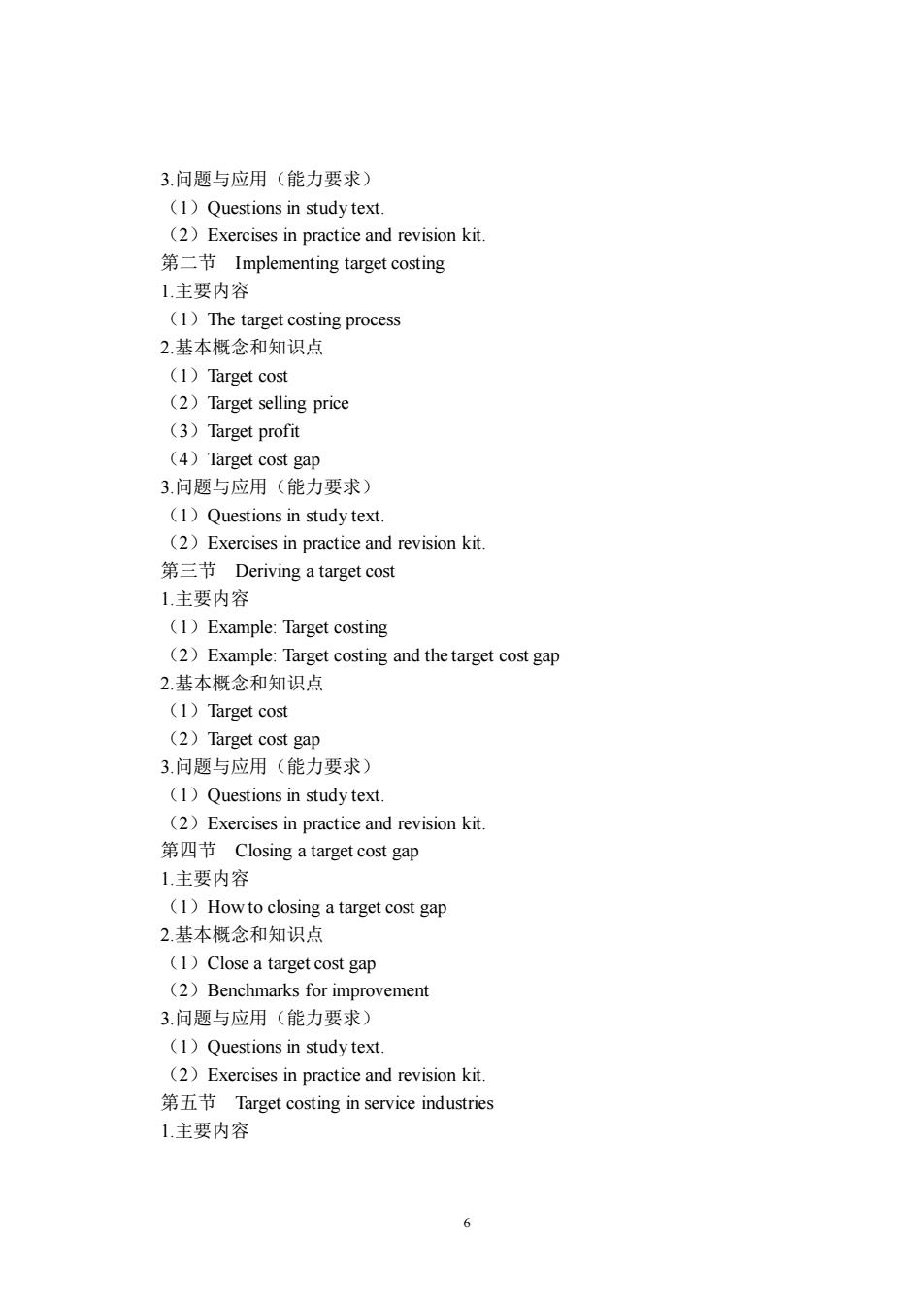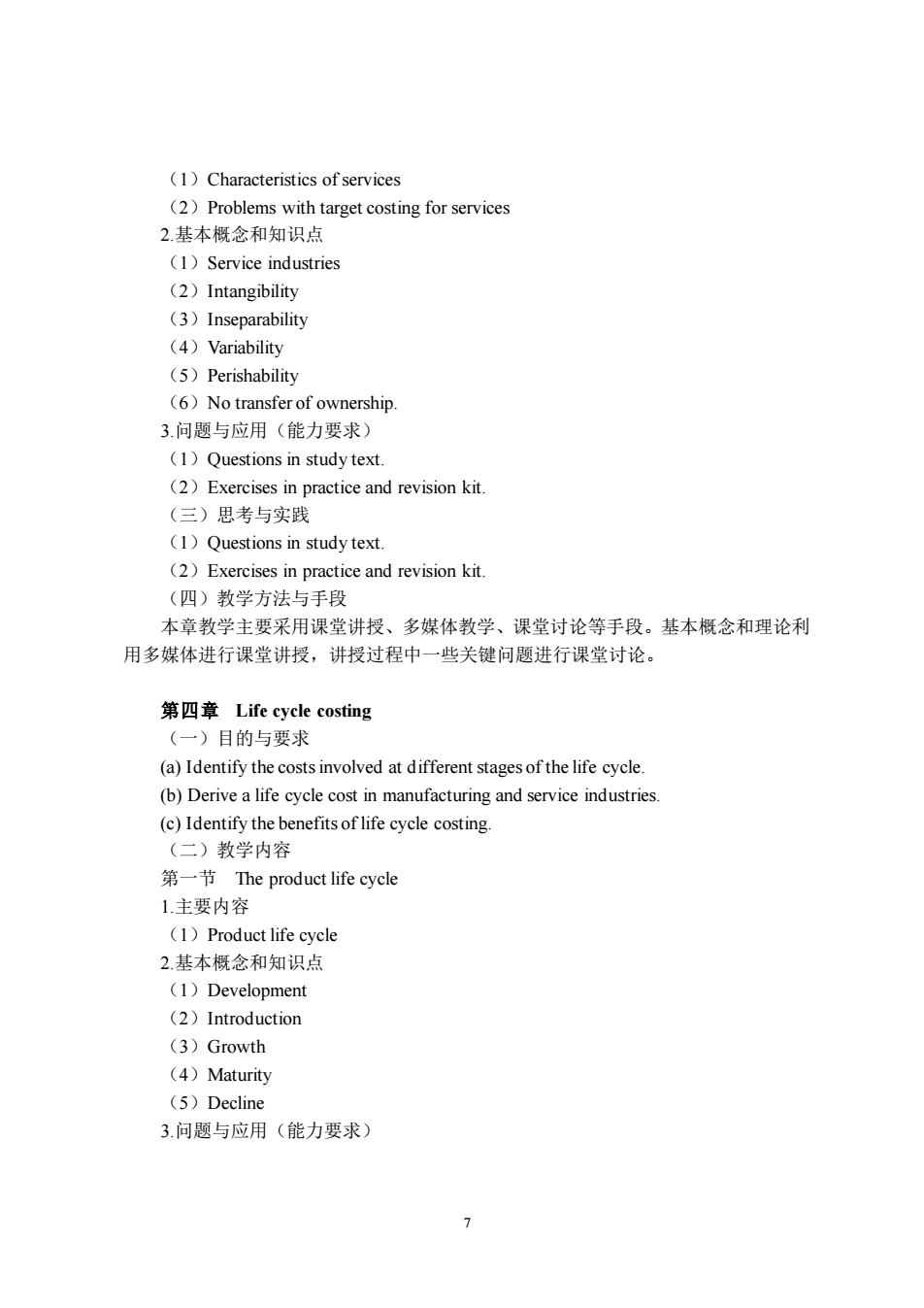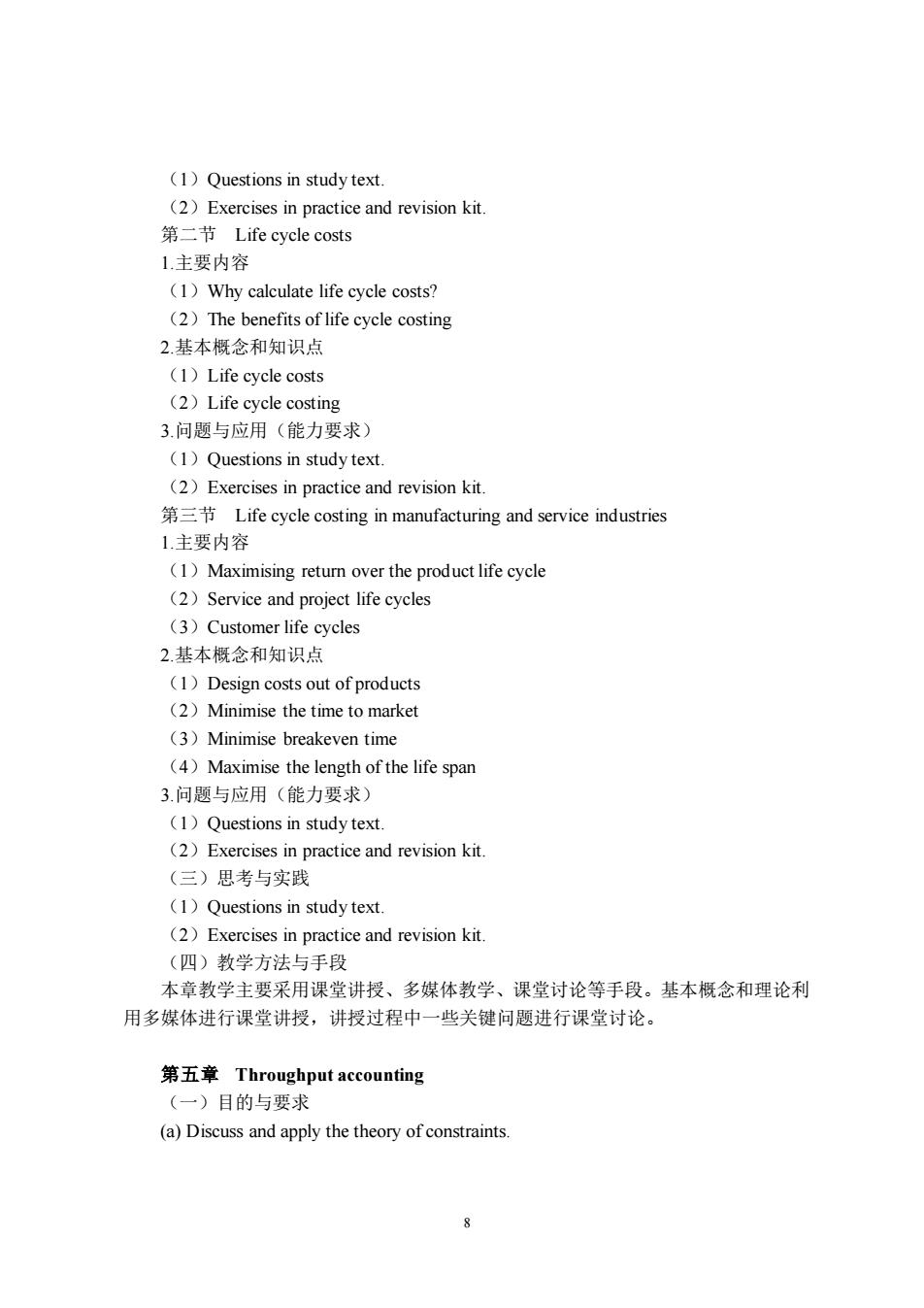
3.问题与应用(能力要求) (1)Questions in study text. (2)Exereises in practice and revision kit. 第二节Implementing target costing 1主要内容 (1)The target costing process 2.基本概念和知识点 (1)Target cost (2)Target selling price (3)Target profit (4)Target cost a即 3间题与应用(能力要求) (1)Questions in study tex (2)Exercises in practice and revision kit. 第三节Deriving a target cost 1主要内容 (1)Example:Target costing (2)Example:Target costing and the target cost gap 2.基本概念和知识点 (1)Target cost (2)Target cost gap 3.问题与应用(能力要求) (1)Questions in study text. (2)Exercises in practice and revision kit. 第四节Closing a target cost gap 1主要内容 (1)How to closing a target cost gap 2基本橱今和知识点 (1)Close a target cost gap (2)Benchmarks for improvement 3.问题与应用(能力要求) (1)Questions in study text (2)Exercises in practice and revision kit. 第五节Target costing in service industries 1主要内容
6 3.问题与应用(能力要求) (1)Questions in study text. (2)Exercises in practice and revision kit. 第二节 Implementing target costing 1.主要内容 (1)The target costing process 2.基本概念和知识点 (1)Target cost (2)Target selling price (3)Target profit (4)Target cost gap 3.问题与应用(能力要求) (1)Questions in study text. (2)Exercises in practice and revision kit. 第三节 Deriving a target cost 1.主要内容 (1)Example: Target costing (2)Example: Target costing and the target cost gap 2.基本概念和知识点 (1)Target cost (2)Target cost gap 3.问题与应用(能力要求) (1)Questions in study text. (2)Exercises in practice and revision kit. 第四节 Closing a target cost gap 1.主要内容 (1)How to closing a target cost gap 2.基本概念和知识点 (1)Close a target cost gap (2)Benchmarks for improvement 3.问题与应用(能力要求) (1)Questions in study text. (2)Exercises in practice and revision kit. 第五节 Target costing in service industries 1.主要内容

(1)Characteristics of services (2)Problems with target costing for services 2.基本概念和知识点 (1)Service industries (2)Intangibility (3)Inseparability (4)Variability (5)Perishability (6)No transfer of ownership 3.问题与应用(能力要求) (1)Questions in study text (2)Exercises in practice and revision kit. (三)思考与实践 (1 Questions in study text. (2Exercises in practice and revision kit (四)教学方法与手段 本章教学主要采用课堂讲授、多媒体教学、课堂讨论等手段。基本概念和理论利 用多媒体进行课堂讲授,讲授过程中一些关键问题进行课堂讨论。 第四章Life eyele costing (一)目的与要求 (a)Identify the costs involved at different stages of the life cycle. (b)Derive a life cycle cost in manufacturing and service industries (c)Identify the benefits of life cycle costing (二)教学内容 第一节The product life cycle 1主要内容 (1)Product life cycle 2基本概念和知识点 (1)Development (2)Introduction (3)Growth (4)Maturity (5)Decline 3.问题与应用(能力要求)
7 (1)Characteristics of services (2)Problems with target costing for services 2.基本概念和知识点 (1)Service industries (2)Intangibility (3)Inseparability (4)Variability (5)Perishability (6)No transfer of ownership. 3.问题与应用(能力要求) (1)Questions in study text. (2)Exercises in practice and revision kit. (三)思考与实践 (1)Questions in study text. (2)Exercises in practice and revision kit. (四)教学方法与手段 本章教学主要采用课堂讲授、多媒体教学、课堂讨论等手段。基本概念和理论利 用多媒体进行课堂讲授,讲授过程中一些关键问题进行课堂讨论。 第四章 Life cycle costing (一)目的与要求 (a) Identify the costs involved at different stages of the life cycle. (b) Derive a life cycle cost in manufacturing and service industries. (c) Identify the benefits of life cycle costing. (二)教学内容 第一节 The product life cycle 1.主要内容 (1)Product life cycle 2.基本概念和知识点 (1)Development (2)Introduction (3)Growth (4)Maturity (5)Decline 3.问题与应用(能力要求)

(1)Questions in study text. (2)Exercises in practice and revision kit. 第二节Life cycle costs 1.主要内容 (1)Why calculate life cycle costs? (2)The benefits of life cycle costing 2.基本概念和知识点 (1)Life cycle costs (2)Life cycle costing 3.问题与应用(能力要求) (1)Questions in study text (2)Exercises in practice and revision kit. 第三节Life cycle costing in manufacturing and service industries 1.主要内容 (1Maximising retum over the product life cycle (2)Service and project life cycles (3)Customer life cycles 2.基本概念和知识点 (1Design costs out of products (2)Minimise the time to market (3)Minimise breakeven time (4)Maximise the length of the life span 3.问题与应用(能力要求) (1)Questions in study text. (2)Exercises in practice and revision kit (三)思考与实践 (1)Questions in study text. (2)Exercises in practice and revision kit. (四)教学方法与手段 本章教学主要采用课堂讲授、多媒体教学、课堂讨论等手段。基本概念和理论利 用多媒体进行课堂讲授,讲授过程中一些关键问题进行课堂讨论。 第五章Throughput accounting (一)目的与要求 (a)Discuss and apply the theory of constraints
8 (1)Questions in study text. (2)Exercises in practice and revision kit. 第二节 Life cycle costs 1.主要内容 (1)Why calculate life cycle costs? (2)The benefits of life cycle costing 2.基本概念和知识点 (1)Life cycle costs (2)Life cycle costing 3.问题与应用(能力要求) (1)Questions in study text. (2)Exercises in practice and revision kit. 第三节 Life cycle costing in manufacturing and service industries 1.主要内容 (1)Maximising return over the product life cycle (2)Service and project life cycles (3)Customer life cycles 2.基本概念和知识点 (1)Design costs out of products (2)Minimise the time to market (3)Minimise breakeven time (4)Maximise the length of the life span 3.问题与应用(能力要求) (1)Questions in study text. (2)Exercises in practice and revision kit. (三)思考与实践 (1)Questions in study text. (2)Exercises in practice and revision kit. (四)教学方法与手段 本章教学主要采用课堂讲授、多媒体教学、课堂讨论等手段。基本概念和理论利 用多媒体进行课堂讲授,讲授过程中一些关键问题进行课堂讨论。 第五章 Throughput accounting (一)目的与要求 (a) Discuss and apply the theory of constraints

(b)Calculate and interpret a throughput accounting ratio(TPAR). (c)Suggest how a TPAR could be improved. (d)Apply throughput accounting to a multi-product decision-making problem. (二)教学内容 第一节Theory of constraints 1主要内容 (1)Throughput:sales,inventory and operational expenses (2)Bottleneck factor:the constraint (3)Production scheduling and the bottleneck resource (4)Increasing throughput:elevating the bottleneck (5)Example:elevating the constraint (6)Theory of constraints:summary (7)Example:An illustration of the theory of constraints 2.基本概念和知识点 (1)Theory of constraints(TOC) (2)Throughput (3Bottleneck resource or binding constrain 3.问题与应用(能力要求) (1)Questions in study text (2)Exercises in practice and revision kit. 第二节Throughput accounting 1主要内容 (1)Throughput accounting (TA) (2)Throughput accounting in a service industry 2.基本概念和知识点 (1)Throughput accounting(TA) (2JIT production 3.问题与应用(能力要求) (1)Questions in study text. (2)Exercises in practice and revision kit. s第三节Performance measures in throughput accounting 1.主要内容 (1)Example:Maximising throughput and multiple products (2)Throughput accounting and limiting factor analysis compared 2.基本概念和知识点
9 (b) Calculate and interpret a throughput accounting ratio (TPAR). (c) Suggest how a TPAR could be improved. (d) Apply throughput accounting to a multi-product decision-making problem. (二)教学内容 第一节 Theory of constraints 1.主要内容 (1)Throughput: sales, inventory and operational expenses (2)Bottleneck factor: the constraint (3)Production scheduling and the bottleneck resource (4)Increasing throughput: elevating the bottleneck (5)Example: elevating the constraint (6)Theory of constraints: summary (7)Example: An illustration of the theory of constraints 2.基本概念和知识点 (1)Theory of constraints (TOC) (2)Throughput (3)Bottleneck resource or binding constraint 3.问题与应用(能力要求) (1)Questions in study text. (2)Exercises in practice and revision kit. 第二节 Throughput accounting 1.主要内容 (1)Throughput accounting (TA) (2)Throughput accounting in a service industry 2.基本概念和知识点 (1)Throughput accounting (TA) (2)JIT production 3.问题与应用(能力要求) (1)Questions in study text. (2)Exercises in practice and revision kit. 第三节 Performance measures in throughput accounting 1.主要内容 (1)Example: Maximising throughput and multiple products (2)Throughput accounting and limiting factor analysis compared 2.基本概念和知识点

(1)Performance measures (2)Multiple products (3)Limiting factor analysis 3问题与应用(能力要求) (1)Questions in study text (2)Exercises in practice and revision kit. 第四节Throughput accounting ratio 1主要内容 (1)Interpreting the TA ratio (2)Example:TA ratios and ranking products (3)How can a business improve a throughput accounting ratio? (4)Throughput and limiting factor analysis 2.基本概念和知识点 (1)Throughput accounting ratio (TA ratio) (2)Ranking products 3.问题与应用(能力要求) (1)Questions in study text (2)Exercises in practice and revision kit. (三)思考与实践 (1)Questions in study text. (2)Exercises in practice and revision kit (四)教学方法与手段 本章教学主要采用课堂讲授、多媒体教学、课堂讨论等手段。基本概念和理论利 用多媒体进行课堂讲授,讲授过程中一些关键问题进行课堂讨论。 第六章Environmental accounting (一)目的与要求 (a)Environmental cost pays attention to environmental regulation and environmental cost,which is conducive to building a beautiful China. (b)Discuss the issues businesses face in the management of environmental costs. (c)Describe the different methods a business may use to account for its environmental costs (二)教学内容 第-节Managing environmental cost 1主要内容 10
10 (1)Performance measures (2)Multiple products (3)Limiting factor analysis 3.问题与应用(能力要求) (1)Questions in study text. (2)Exercises in practice and revision kit. 第四节 Throughput accounting ratio 1.主要内容 (1)Interpreting the TA ratio (2)Example: TA ratios and ranking products (3)How can a business improve a throughput accounting ratio? (4)Throughput and limiting factor analysis 2.基本概念和知识点 (1)Throughput accounting ratio (TA ratio) (2)Ranking products 3.问题与应用(能力要求) (1)Questions in study text. (2)Exercises in practice and revision kit. (三)思考与实践 (1)Questions in study text. (2)Exercises in practice and revision kit. (四)教学方法与手段 本章教学主要采用课堂讲授、多媒体教学、课堂讨论等手段。基本概念和理论利 用多媒体进行课堂讲授,讲授过程中一些关键问题进行课堂讨论。 第六章 Environmental accounting (一)目的与要求 (a) Environmental cost pays attention to environmental regulation and environmental cost, which is conducive to building a beautiful China. (b) Discuss the issues businesses face in the management of environmental costs. (c) Describe the different methods a business may use to account for its environmental costs (二)教学内容 第一节 Managing environmental costs 1.主要内容